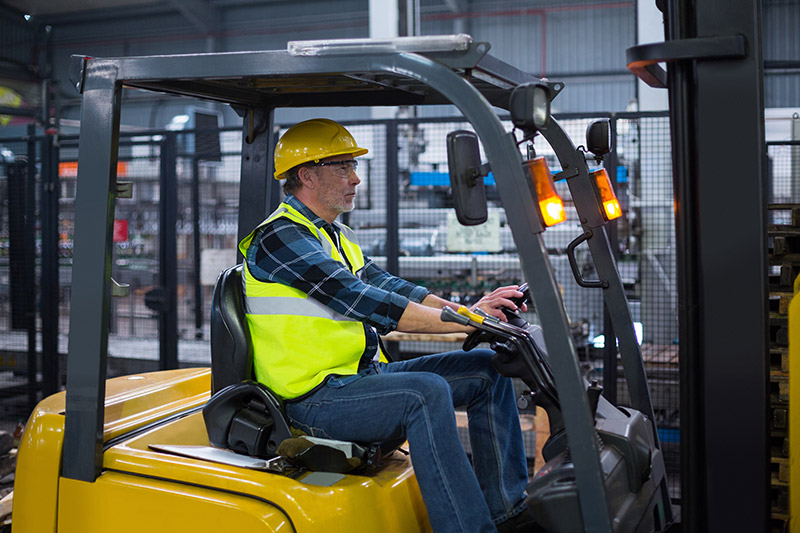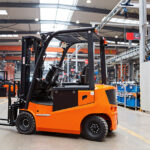Since the advent of YouTube, Vimeo, and other online video platforms, countless videos have surfaced showcasing forklift operators causing severe accidents. These videos resurface in cycles, prompting CEOs and warehouse safety coordinators to review and assess the safety protocols in their warehouses, manufacturing plants, and distribution centers to ensure all necessary precautions are in place. No one ever wants an accident to happen!
Accidents are unpredictable by nature, but the goal of every CEO and Safety Coordinator is to drastically reduce or eliminate reportable accidents. Below are 11 effective ways to reduce accidents in your facility:
Certify your forklift operators. It’s surprising how many large and small companies fail to certify their forklift operators. While forklifts may have an accelerator and brake, operating them is entirely different from driving a car, and proper training is essential.
Yearly refresher courses. No matter how long an operator has been working, an annual refresher course is crucial. Complacency can set in, and regular training ensures operators maintain their skills.
Limit top speeds in the warehouse. Forklifts are designed to transport materials efficiently, but speed can vary depending on the facility. In less congested areas, higher speeds may be safe, but in busier warehouses, speeding can lead to accidents. Evaluate the safe speed for your facility and consider limiting the speed of your forklift fleet.
High-visibility seatbelts. Simply switching to high-visibility seatbelts can be an effective way to ensure operators are buckled up. This simple but impactful change can help prevent accidents.
Fleet management and driver accountability systems. Implementing a system that tracks speed, impacts, and maintenance can help improve safety and hold operators accountable for their actions.
Use the horn. It might seem basic, but using the horn at intersections, when backing up, and periodically while moving through the warehouse helps alert others to your presence, enhancing safety.
Back-up alarms. While they might seem annoying, back-up alarms are invaluable in a warehouse setting. New “smart” alarms adjust their volume based on the forklift’s speed, making them more tolerable for both operators and pedestrians.
Use different color strobe lights. Many companies are moving away from traditional amber or yellow strobe lights and opting for different colors to grab attention. Simple changes like this can reinvigorate safety awareness.
Ensure proper warehouse illumination. Cutting down on lighting to save money can backfire if the warehouse is left poorly lit. Poor visibility can lead to accidents, negating any cost savings with potential lawsuits.
Take a break near shift end. Most accidents and product damage occur toward the end of shifts, as fatigue sets in. A short break before the end of the shift can keep operators alert and reduce accidents.
Use forklift lights. Forklift lights are there for a reason. Even in well-lit warehouses, using forklift lights improves visibility and alerts others to the forklift’s presence.
Since the advent of YouTube, Vimeo, and other online video platforms, countless videos have surfaced showcasing forklift operators causing severe accidents. These videos resurface in cycles, prompting CEOs and warehouse safety coordinators to review and assess the safety protocols in their warehouses, manufacturing plants, and distribution centers to ensure all necessary precautions are in place. No one ever wants an accident to happen!
Accidents are unpredictable by nature, but the goal of every CEO and Safety Coordinator is to drastically reduce or eliminate reportable accidents. Below are 11 effective ways to reduce accidents in your facility:
Certify your forklift operators. It’s surprising how many large and small companies fail to certify their forklift operators. While forklifts may have an accelerator and brake, operating them is entirely different from driving a car, and proper training is essential.
Yearly refresher courses. No matter how long an operator has been working, an annual refresher course is crucial. Complacency can set in, and regular training ensures operators maintain their skills.
Limit top speeds in the warehouse. Forklifts are designed to transport materials efficiently, but speed can vary depending on the facility. In less congested areas, higher speeds may be safe, but in busier warehouses, speeding can lead to accidents. Evaluate the safe speed for your facility and consider limiting the speed of your forklift fleet.
High-visibility seatbelts. Simply switching to high-visibility seatbelts can be an effective way to ensure operators are buckled up. This simple but impactful change can help prevent accidents.
Fleet management and driver accountability systems. Implementing a system that tracks speed, impacts, and maintenance can help improve safety and hold operators accountable for their actions.
Use the horn. It might seem basic, but using the horn at intersections, when backing up, and periodically while moving through the warehouse helps alert others to your presence, enhancing safety.
Back-up alarms. While they might seem annoying, back-up alarms are invaluable in a warehouse setting. New “smart” alarms adjust their volume based on the forklift’s speed, making them more tolerable for both operators and pedestrians.
Use different color strobe lights. Many companies are moving away from traditional amber or yellow strobe lights and opting for different colors to grab attention. Simple changes like this can reinvigorate safety awareness.
Ensure proper warehouse illumination. Cutting down on lighting to save money can backfire if the warehouse is left poorly lit. Poor visibility can lead to accidents, negating any cost savings with potential lawsuits.
Take a break near shift end. Most accidents and product damage occur toward the end of shifts, as fatigue sets in. A short break before the end of the shift can keep operators alert and reduce accidents.
Use forklift lights. Forklift lights are there for a reason. Even in well-lit warehouses, using forklift lights improves visibility and alerts others to the forklift’s presence.
These simple tips are followed by some and overlooked by others daily. Take a moment today to see which of these safety measures you can implement in your facility to improve forklift operation safety.
These simple tips are followed by some and overlooked by others daily. Take a moment today to see which of these safety measures you can implement in your facility to improve forklift operation safety.



